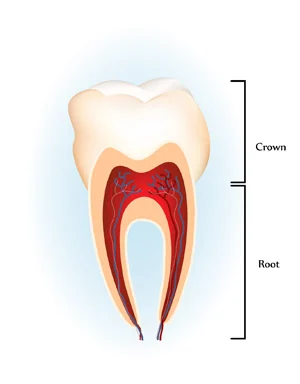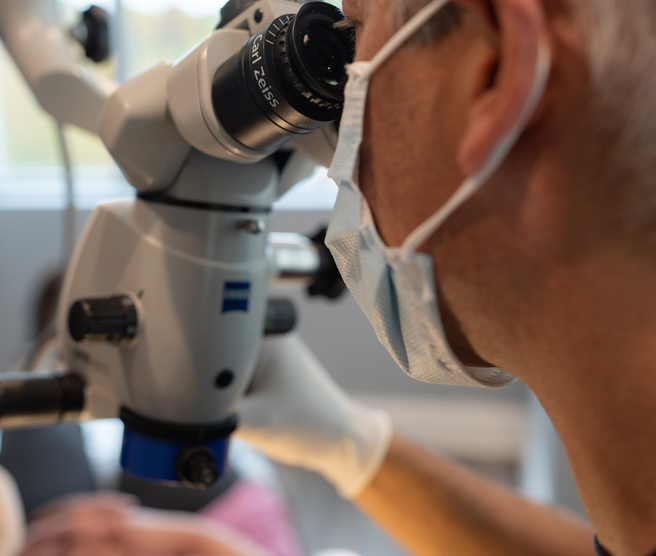About Your Tooth


Your tooth consists of two main parts: the crown, which is that part of the tooth above the gum and visible in your mouth; and the root or roots, which is that part of the tooth that lies beneath the gum and is surrounded by bone. Inside each root is a channel that runs the length of the tooth. This channel is the root canal and contains the pulp (nerves, blood vessels, and soft tissue), which is often referred to as the “nerve” of the tooth. The pulp may be irreversibly damaged by bacteria associated with decay, very deep restorations, fractures, trauma, or periodontal disease.
In order to preserve a tooth in which this has occurred, it is necessary to remove the diseased pulp tissue. This procedure is known as endodontic therapy. Since endodontic therapy is concerned with removing only the pulp from the root canal, the root will continue to function normally because the supporting tissues remain intact. It is advisable to remove the injured pulp because it may become infected or act as an irritant to the tissues surrounding the tooth.
Saving Teeth
Tooth Saving Tips
Patients today have more options than ever before to treat their teeth. Understanding your choices and their impact on your future dental health and lifestyle is important. Saving a natural tooth through endodontic treatment should always be the first choice for the best health and cosmetic results.There are many advantages to saving your natural tooth:
- Efficient chewing
- Normal biting force, so you can continue to eat your favorite foods
- Maintains a natural appearance
- Limits the need for more costly, ongoing dental work

Tips for Saving Your Teeth
If you are given a choice between root canal treatment or tooth extraction, consider choosing root canal treatment. Dentistry has yet to produce a denture, bridge or implant that looks, feels and functions as well as a natural tooth.
If your dentist recommends tooth extraction, ask whether root canal treatment is an option.
If your dentist says that an endodontic procedure is not an option, ask why, and request a referral to an endodontist. Endodontists are dentists who specialize in saving teeth, and have at least two years of advanced training in root canal procedures. They are experts at diagnosing and relieving tooth pain, and use advanced equipment to treat patients quickly and comfortably. Your dentist probably has partnerships with endodontists in your area already.
What to Avoid
Never choose extraction because you think it will be cheaper! When a natural tooth is extracted, it is typically replaced with an artificial tooth to prevent other teeth from shifting, and to prevent future dental problems. The cost of a denture, bridge or implant, plus the extraction, is several times higher than the cost of an endodontic procedure that would save the tooth for years to come. Most dental insurance plans cover endodontic treatment. Never choose extraction because you think root canal treatment will be painful! Modern techniques and effective anesthesia make root canal treatment virtually painless. In fact, discomfort after the procedure is generally greater with a tooth extraction. Patients who have experienced root canal treatment are six times more likely to describe it as “painless” than patients who have not had a root canal. Never choose extraction because you think it will be quicker! Endodontic treatments generally require one to two visits lasting less than an hour each. An extraction requires one visit, but the denture, bridge or implant will require several additional visits with your dentist.
Tooth Pain Guide
Please select from the list below the title that best reflects your pain.
Possible Problem
If the discomfort lasts only moments, sensitivity to hot and cold foods generally does not signal a problem. The sensitivity may be caused by a loose filling or by minimal gum recession which exposes small areas of the root surface.
What To Do
Try using toothpastes made for sensitive teeth. Brush up and down with a soft brush; brushing sideways wears away exposed root surfaces. If this is unsuccessful, see your dentist.
Possible Problem
Dental work may inflame the pulp, inside the tooth, causing temporary sensitivity.
What To Do
Wait four to six weeks. If the pain persists or worsens, see your dentist.
Possible Problem
There are several possible causes of this type of pain: decay, a loose filling, or a crack in the tooth. There may be damage to the pulp tissue inside the tooth.
What To Do
See a dentist for evaluation. If the problem is a cracked tooth, your dentist may send you to an endodontist. Cracked tooth pain comes from damage to the inner soft tissue of the tooth, the pulp. Endodontists are dentists who specialize in pulp-related procedures. Endodontic treatment, also known as root canal treatment, can relieve that pain.
Possible Problem
This probably means the pulp has been damaged by deep decay or physical trauma.
What To Do
See your endodontist to save the tooth with root canal treatment.
Possible Problem
A tooth may have become abscessed, causing the surrounding bone to become infected.
What To Do
See your endodontist for evaluation and treatment to relieve the pain and save the tooth. Take over-the-counter analgesics until you see the endodontist.
Possible Problem
The pain of a sinus headache is often felt in the face and teeth. Grinding of teeth, a condition known as bruxism, can also cause this type of ache.
What To Do
For sinus headache, try over-the-counter analgesics or sinus medicine. For bruxism, consult your dentist. If pain is severe and chronic, see your physician or endodontist for evaluation.
Possible Problem
Sometimes pulp-damaged teeth cause pain in other parts of the head and neck, but other dental or medical problems may be responsible.
What To Do
See your endodontist for evaluation. If the problem is not related to the tooth, your endodontist will refer you to an appropriate dental specialist or a physician.

